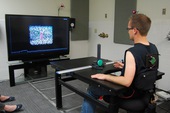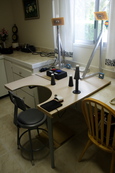Highlight
Mixed Reality Rehabilitation System Shows Promise in Helping Stroke Survivors
Achievement/Results
An interdisciplinary team headed by six IGERT faculty members (Rikakis, Sundaram, He, Qian, Ingalls, Jasemidis) has developed a novel adaptive mixed reality rehabilitation (AMRR) system for stroke survivors; the system seeks to improve the reaching movements of people who have hemiparesis resulting from stroke. The research team includes eight IGERT trainees.
The AMMR system for stroke rehabilitation integrates traditional rehabilitation and motor learning theories with state of the art motion capture and sensing technologies, smart physical objects, and interactive computer graphics and sound. This unique configuration provides real-time, intuitive, and integrated audio and visual feedback representative of key movement aspects during a reach and grasp task to the stroke survivor using the system. It facilitates self-assessment and motor plan development by the stroke survivor. The system also provides a kinematics-based quantitative evaluation that classifies movement components on a scale between severe impairment and idealized movement. The therapist can use this evaluation to adapt the focus of the therapy task and feedback to customize therapy for the specific needs of the stroke survivor. The success of the system requires extensive collaboration among engineers, clinicians, scientists and artists.
The IGERT award has made this collaboration possible through its funding and interdisciplinary initiatives. The fast advancing research gains of this past year promise outcomes of significant societal impact by the end of the IGERT award. The system was installed at Banner Baywood Medical Center and a clinical study comparing AMRR therapy to traditional physical therapy began in April 2009.
Seven stroke survivors have completed AMRR therapy and five stroke survivors have completed traditional therapy. Both groups underwent training for 12 75-minute sessions, 3 times a week for 4 weeks. Preliminary results show that the kinematic performance of the subjects in the AMRR group improved more consistently and with greater magnitude than those in the traditional rehab group. All seven subjects in the AMRR group made improvements in key kinematic attributes such as more accurate target acquisition, faster and smoother movement of reach, increased joint coordination and reduced compensatory use of the torso and shoulder. The results also show that the system enables integrated improvement for most kinematic attributes, not just those focused on during therapy. Clinical scale results suggest that our system can successfully promote the transfer of learned movement strategies to daily life activities. The system was accepted and understood by the patients and clinicians.
Three interdisciplinary teams of IGERT trainees completed month-long AMRR training of stroke survivors in collaboration with physical therapists and medical doctors from the Rhodes Rehabilitation Center at Banner Baywood. Each team included three IGERT trainees (typically an engineering student and a media arts and sciences student, with a bioengineering student overseeing each team), a physical therapist and a medical doctor. This experience has provided IGERT trainees with first hand experience in applying their integrated disciplinary knowledge and interdisciplinary, team based training to a real world context. Students were required to communicate across multiple disciplines on a daily basis to solve the challenges of successfully applying AMRR to fit each subject’s needs and progress.
The team has also begun to develop a portable, low-cost, home-based system on which stroke survivors can continue their therapy outside of the clinic. An initial home-based system was developed and used by two subjects, from which basic kinematic data and patient usage patterns were collected. The overall response from both users was positive, both from anecdotal evidence and from usage patterns above the minimum requirements. A mediated home-based therapy system is in development and will use many of the concepts developed from the clinical system. This system will give the subjects freedom to continue their rehabilitation training at their convenience, with weekly check-ins with the therapist. The therapist will also remotely monitor the subject’s progress and usage and adapt the therapy protocol based on that data. The home-based system provides a convenient, low-cost alternative to extensive clinical therapy, while empowering the stroke survivor to become the driving force behind his or her recovery.
The team is also developing a semi-automated adaptation framework for the home system based on analysis of the clinical data. Preliminary work has also been done in developing a system to monitor performance of activities of daily living in the home. In the past year, the team has begun to investigate biomedical and computational methods to further our understanding of the physiological effects of the AMRR therapy system on stroke survivors. Neurological and neuromuscular signal monitoring, which will supplement the kinematic data, has been initiated to explore the effects of AMRR on neural plasticity.
The team is also developing computational approaches to discover the correlation between kinematic improvements and training strategies and feedback presented during the therapy. The correlation discovery will facilitate the semi-automated adaptation of therapy at the hospital and the home and the development of related evaluation and feedback frameworks.
Six journal publications prepared by our team this year present the above development work and study results. They provide increasing evidence that the combination of intensive therapy at the hospital with long-term therapy at the home using semi-automated, adaptive, mixed reality rehabilitation systems can significantly enhance recovery of stroke survivors.
Address Goals
This activity has furthered the development of novel computing technologies for the advancement of health services by increasing our critical knowledge of how mediated therapy and computational analysis can help enhance recovery of stroke survivors.
Stroke is the leading cause of long-term adult disability in the United States. Challenges associated with current rehabilitation techniques include insufficient intensity, high cost of maintaining the duration of therapy, lack of standardized, detailed quantitative measures for tracking therapy outcomes across large numbers of stroke survivors and lack of assistive tools for facilitating prognosis and customized therapy. The further development of a home-based rehabilitation system is directly addressing limited provision of support by health insurance beyond the initial stages of recovery, which may significantly limit the full potential of recovery for each individual stroke survivor. The extensive understanding of how mediated therapy affects stroke rehabilitation enables long term, interactive home-based therapy driven by the stroke survivor and enhanced intensive therapy at the clinical setting driven by the clinician.
Computational analysis tools driven by real time kinematic, brain activity and muscle activity data allow for better prognosis, tracking and customization of therapy. The findings of this IGERT activity also contribute significant knowledge to the development of cyber-physical systems of societal impact, which has been identified by the NSF as a key research area for computing and engineering. This activity also trains scientists and engineers that can work across disciplines to develop innovative technologies for health care and in general collaborate towards solving complex problems. It prepares scientists that can integrate a great range of viewpoints spanning medicine, engineering, science, humanities and the arts. Finally, it proposes models of education where cutting edge research and education is embedded in real world contexts for solving real world problems.








